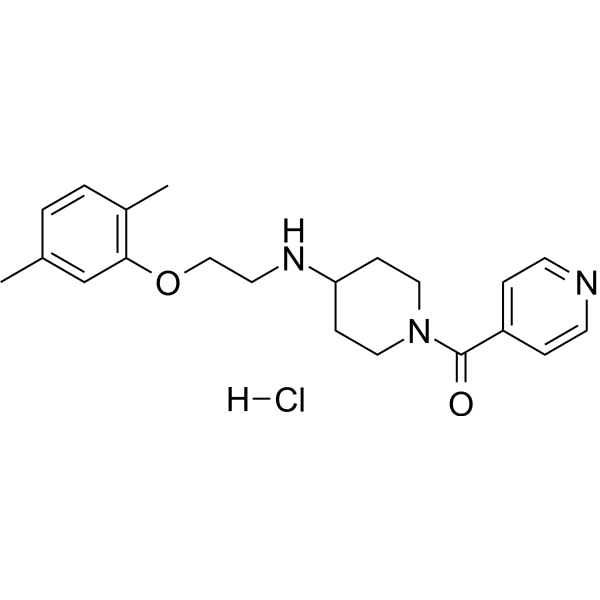Physicochemical Properties
| CAS # | 2803211-60-9 |
| Related CAS # | GRP-60367;1309241-34-6 |
| Appearance | Off-white to light yellow solid powder |
| HS Tariff Code | 2934.99.9001 |
| Storage |
Powder-20°C 3 years 4°C 2 years In solvent -80°C 6 months -20°C 1 month Note: Please store this product in a sealed and protected environment, avoid exposure to moisture. |
| Shipping Condition | Room temperature (This product is stable at ambient temperature for a few days during ordinary shipping and time spent in Customs) |
Biological Activity
| ln Vitro | In dose-response experiments, GRP-60367 (0.1 nM-1000 μM) demonstrates the scaffold's strong and specific anti-RABV action, with EC50 values ranging from 2 to 52 nM on several host cell lines[1]. |
| Cell Assay |
Cell Viability Assay[1] Cell Types: BEAS-2B, 293T, or Hep-2 cell lines Tested Concentrations: 0.1 nM, 1 nM, 10 nM, 100 nM, 1 μM, 10 μM, 100 μM, 1000 μM Incubation Duration: 48 hrs (hours) Experimental Results: EC50s of 2 nM, 3 nM, and 52 nM for RABV-ΔG-nanoLuc virus in BEAS-2B, 293T, or Hep-2 cell lines, respectively. |
| References |
[1]. Identification and Characterization of a Small-Molecule Rabies Virus Entry Inhibitor. J Virol. 2020 Jun 16;94(13):e00321-20. |
Solubility Data
| Solubility (In Vitro) | DMSO : 250 mg/mL (641.16 mM) |
| Solubility (In Vivo) |
Solubility in Formulation 1: ≥ 2.08 mg/mL (5.33 mM) (saturation unknown) in 10% DMSO + 40% PEG300 + 5% Tween80 + 45% Saline (add these co-solvents sequentially from left to right, and one by one), clear solution. For example, if 1 mL of working solution is to be prepared, you can add 100 μL of 20.8 mg/mL clear DMSO stock solution to 400 μL PEG300 and mix evenly; then add 50 μL Tween-80 to the above solution and mix evenly; then add 450 μL normal saline to adjust the volume to 1 mL. Preparation of saline: Dissolve 0.9 g of sodium chloride in 100 mL ddH₂ O to obtain a clear solution. Solubility in Formulation 2: ≥ 2.08 mg/mL (5.33 mM) (saturation unknown) in 10% DMSO + 90% (20% SBE-β-CD in Saline) (add these co-solvents sequentially from left to right, and one by one), clear solution. For example, if 1 mL of working solution is to be prepared, you can add 100 μL of 20.8 mg/mL clear DMSO stock solution to 900 μL of 20% SBE-β-CD physiological saline solution and mix evenly. Preparation of 20% SBE-β-CD in Saline (4°C,1 week): Dissolve 2 g SBE-β-CD in 10 mL saline to obtain a clear solution. Solubility in Formulation 3: ≥ 2.08 mg/mL (5.33 mM) (saturation unknown) in 10% DMSO + 90% Corn Oil (add these co-solvents sequentially from left to right, and one by one), clear solution. For example, if 1 mL of working solution is to be prepared, you can add 100 μL of 20.8 mg/mL clear DMSO stock solution to 900 μL of corn oil and mix evenly. (Please use freshly prepared in vivo formulations for optimal results.) |
